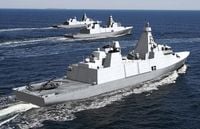The shipbuilding industry in Scotland is on the cusp of a remarkable resurgence, with Babcock’s Rosyth yard in Fife poised to secure a £1 billion contract to build four Type 31 frigates for the Danish navy. This anticipated deal, expected to be finalized in the coming months, signals a new era for the historic dockyard and for British naval exports more broadly. The Rosyth site, operated by the British-based defense giant Babcock, is also in the running for another major contract: up to seven Type 31 frigates for the Swedish navy, in a competitive process that pits it directly against a French shipyard with strong government backing, according to BBC.
The momentum at Rosyth follows closely on the heels of a significant win by BAE Systems, which recently secured a contract to build larger Type 26 ships for the Royal Norwegian Navy at its Govan and Scotstoun yards on the Clyde. Prime Minister Sir Keir Starmer himself visited Glasgow to mark that achievement, underscoring the renewed focus on British shipbuilding as a pillar of both regional and national economic growth.
The Type 31 frigate, known internationally as the Arrowhead 140, is a general-purpose fighting ship designed for adaptability and affordability. At 139 meters (or 455 feet) in length and weighing 5,700 tonnes, the Type 31 is based on a proven Danish design but has been optimized for rapid construction and export flexibility. As Admiral Sir Nick Hine, Babcock’s Director of the Type 31 programme and former Second Sea Lord, explained to journalists, “It’s the ship that navies need. It’s affordable and adaptable and we can deliver it in ten years. That’s never been done before. The future for Rosyth looks really good.”
Currently, five Type 31 Inspiration-class frigates are being built for the Royal Navy, with the first, HMS Venturer, rolled out in May 2025 and now fitting out in dry dock. Two more are under construction, and all five are due to be delivered by 2030. The Arrowhead 140 design has already found international customers in Indonesia and Poland, where Babcock teams are working on-site to support local shipyards. Sir Nick has set an ambitious target: 31 ships built worldwide by 2031, achievable through both UK construction and licensed overseas production.
Babcock’s export drive is not just about ships, but about jobs and skills at home. The Rosyth workforce, currently numbering around 2,500, could swell to 4,000 if both the Danish and Swedish contracts are won. This expansion is already underway, with over 350 Production Support Operatives recruited—many of them older workers retrained after redundancy—and 400 apprentices brought in through partnerships with local colleges. “Their stories are often the ones visitors remember most. People tell me we’ve saved their lives or their families. It’s something I am most proud of,” Babcock Group Chief Executive David Lockwood told the UK Defence Journal.
The company is also investing heavily in infrastructure at Rosyth. Plans are advancing for a second covered build hall, matching the scale of the existing Venturer Building, which would allow two additional frigates to be assembled side by side. This expansion would not only boost capacity for export orders but also provide buffer storage for pre-outfitted blocks and reduce scheduling conflicts with other major projects, such as carrier refits and maintenance of Royal Navy auxiliaries.
Technological innovation is at the heart of Rosyth’s transformation. Journalists touring the site were shown a new ‘q-layers’ ship-painting machine, an automated system that coats hulls faster and more efficiently than traditional methods. The machine uses 20 percent less paint, representing a significant cost saving, and allows other teams to continue work on different parts of the ship while painting is in progress. Augmented Reality headsets are also being trialed, guiding operators step by step through complex production tasks, reducing errors, and accelerating both training and execution.
These digital innovations are already bearing fruit. Workers on the panel line reported that output has risen substantially in the past six months, thanks to new efficiencies and digital methods. Both Lockwood and Hine point to this as evidence that Rosyth can rapidly scale up production if new orders are secured. “Nothing is won until it’s won, but we believe the Type 31 is the best fit for what they want and we can show how we will deliver them. We are confident, not complacent,” Lockwood emphasized at a recent press briefing.
Babcock’s ambitions for Rosyth extend beyond surface shipbuilding. The site is being considered as a third base for the UK’s nuclear submarine enterprise. Infrastructure upgrades costing £340 million are underway, including a contingent docking facility for HMS Dreadnought during its sea trials, according to a parliamentary response from Defence Procurement Minister Maria Eagle. Lockwood clarified the intent: “The aim is to be able to start bringing nuclear submarines in here again, not to break them up, but working submarines.” Sir Nick added, “As part of the Dreadnought safety case for sailing from Barrow, they need to have access to a contingent docking facility that can take Dreadnought. More broadly, if you are going to have a larger fleet, when you’ve got 12 attack submarines not seven, two bases feels too exposed. Having a third base becomes part of the debate.”
Rosyth is also running a trial project to dismantle 23 retired nuclear-powered submarines, a task delayed for decades but now underway with the first vessel, Swiftsure, already having its reactor removed. If successful, this pilot could see Fife become the center for dismantling the UK’s legacy submarine fleet, as 16 more subs await scrapping at Plymouth but lack a clear plan for disposal.
The revitalization of Rosyth has broader economic implications for Scotland and the UK. The anticipated workload could revive demand for rolled steel plates from the Dalzell steelworks in Motherwell, which has been mothballed amid uncertainty over its future. At present, Babcock relies on imported steel, but a Scottish Parliament statement on the plant’s fate is expected soon.
For all the optimism, the future of Rosyth hinges on political decisions in Copenhagen, Stockholm, and Westminster. The contracts under negotiation could reshape the industrial landscape of Fife, securing thousands of jobs and reestablishing Britain as a premier exporter of warships to allied nations. As Lockwood put it, “It helps underpin the UK as an exporter of warships to allied nations, which we haven’t done for a long time. The UK is in a position it hasn’t been in for many decades as a shipbuilder.”
With navies across NATO seeking versatile, affordable, and rapidly built ships to counter new threats, the race for these contracts is fierce. Whether Rosyth will emerge as the new hub of British and European shipbuilding remains to be seen, but the stakes for the region—and the nation—could hardly be higher.





